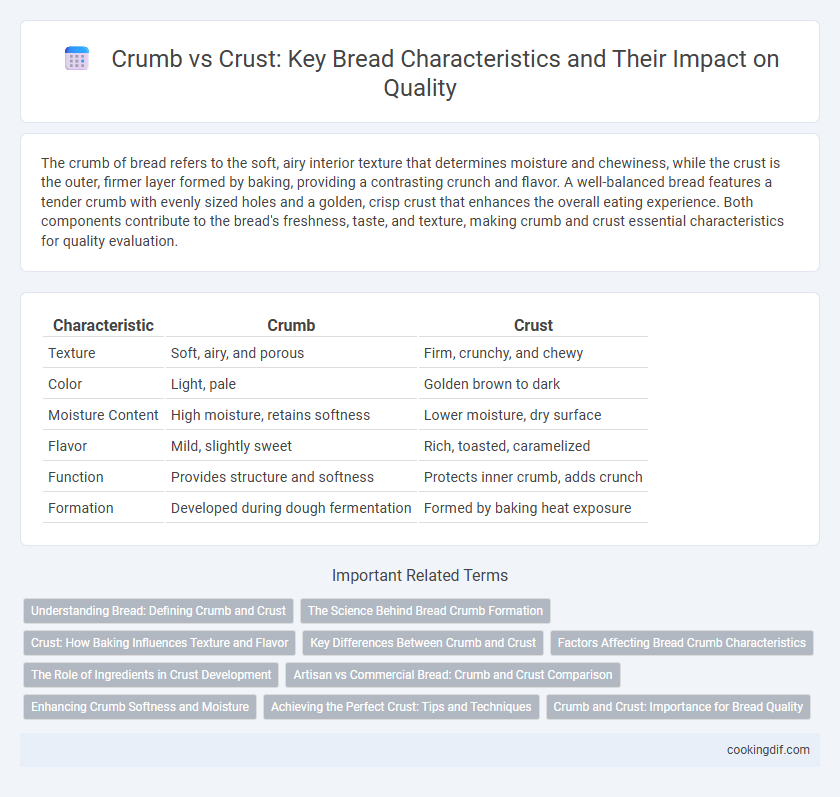The crumb of bread refers to the soft, airy interior texture that determines moisture and chewiness, while the crust is the outer, firmer layer formed by baking, providing a contrasting crunch and flavor. A well-balanced bread features a tender crumb with evenly sized holes and a golden, crisp crust that enhances the overall eating experience. Both components contribute to the bread's freshness, taste, and texture, making crumb and crust essential characteristics for quality evaluation.
Table of Comparison
| Characteristic | Crumb | Crust |
|---|---|---|
| Texture | Soft, airy, and porous | Firm, crunchy, and chewy |
| Color | Light, pale | Golden brown to dark |
| Moisture Content | High moisture, retains softness | Lower moisture, dry surface |
| Flavor | Mild, slightly sweet | Rich, toasted, caramelized |
| Function | Provides structure and softness | Protects inner crumb, adds crunch |
| Formation | Developed during dough fermentation | Formed by baking heat exposure |
Understanding Bread: Defining Crumb and Crust
Crumb refers to the interior texture of bread, characterized by its softness, air pockets, and moisture content, which determine the bread's chewiness and flavor absorption. Crust is the outer layer formed during baking, providing a contrasting crunch and often enhanced flavor through Maillard reaction and caramelization. Understanding the balance between crumb and crust is essential for achieving desired bread qualities such as texture, taste, and shelf life.
The Science Behind Bread Crumb Formation
Bread crumb formation results from the gelatinization of starch and the coagulation of proteins during baking, which create a soft, porous interior texture. Yeast fermentation produces carbon dioxide, leading to gas bubbles trapped in the dough matrix that expand and define crumb structure. The moisture content and baking temperature critically influence crumb softness, elasticity, and shelf life, distinguishing the crumb from the denser, browned crust formed by Maillard reactions and caramelization.
Crust: How Baking Influences Texture and Flavor
The crust of bread forms through the Maillard reaction and caramelization during baking, creating a complex, flavorful outer layer with a crunchy texture. High oven temperatures and steam contribute to a well-developed crust, enhancing both aroma and mouthfeel. This contrast between crust and softer crumb significantly defines the overall sensory experience of bread.
Key Differences Between Crumb and Crust
Crumb refers to the soft, porous interior texture of bread, characterized by its air pockets and elasticity, which influences chewiness and moisture retention. Crust forms the outer layer, typically harder and caramelized due to Maillard reactions during baking, contributing to flavor complexity and a crisp texture. Key differences include moisture content, texture contrast, and the crust's role in protecting the crumb while enhancing overall bread shelf-life.
Factors Affecting Bread Crumb Characteristics
Bread crumb characteristics are influenced by ingredients such as flour type, hydration level, and yeast activity, which impact texture and air cell size. Mixing and fermentation time control gluten development and gas retention, shaping crumb softness and elasticity. Baking temperature and cooling methods affect moisture distribution and crumb structure, crucial for achieving the desired bread quality.
The Role of Ingredients in Crust Development
The role of ingredients like sugar, milk, and fat significantly influences crust development by promoting caramelization and Maillard reactions, which enhance color and flavor complexity. Higher sugar content increases browning intensity, while fats contribute to crust tenderness and sheen. Proper salt levels regulate yeast activity, indirectly affecting crust thickness and texture.
Artisan vs Commercial Bread: Crumb and Crust Comparison
Artisan bread features an open, airy crumb with irregular holes, highlighting natural fermentation and long proofing, while its crust is thick, chewy, and deeply caramelized due to high baking temperatures. Commercial bread typically has a fine, uniform crumb and a thin, soft crust designed for mass production and extended shelf life. The contrast in crumb and crust textures between artisan and commercial bread reflects differences in ingredients, fermentation methods, and baking techniques.
Enhancing Crumb Softness and Moisture
Enhancing crumb softness and moisture in bread relies on factors such as higher hydration levels, the use of fats like butter or oil, and incorporating dough conditioners such as lecithin or ascorbic acid. A tender crumb typically results from enzymatic activity that breaks down starches and proteins, improving softness and moisture retention over time. Unlike the crust, which forms through Maillard reactions and drying during baking, the crumb's structure benefits from careful fermentation and gentle mixing to maintain a moist, open texture.
Achieving the Perfect Crust: Tips and Techniques
Achieving the perfect bread crust requires controlling oven temperature and humidity to enhance Maillard reaction, which creates a golden, crispy exterior. Using steam during the initial baking phase helps develop a thin, crackly crust by maintaining surface moisture and promoting oven spring. Techniques such as scoring the dough allow controlled expansion, preventing cracking and ensuring an even crust texture.
Crumb and Crust: Importance for Bread Quality
The crumb of bread, characterized by its texture, moisture retention, and bubble structure, significantly influences the bread's softness and mouthfeel, impacting consumer satisfaction. The crust provides a contrasting crunch and acts as a protective layer, enhancing flavor through the Maillard reaction and preserving freshness by sealing moisture within the crumb. Together, optimal crumb and crust qualities determine overall bread quality, shelf life, and eating experience, making their balance crucial in artisanal and industrial bread production.
Crumb vs Crust for bread characteristics Infographic

 cookingdif.com
cookingdif.com